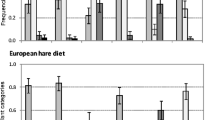Summary
Multidimensional contingency tables provide a powerful new statistical tool for analyzing interactions among several variables in an ecological study. This technique is applied to a study of selectivity in tree-cutting by two colonies of beavers in central Massachusetts.
At the Blue Heron Cove colony, selection depends jointly on genus and diamter. Beavers cut birch of all diameters available but avoid large diameter maples, pines, and oaks. These beavers are choosy generalists: they show clear preferences in cutting various genera of trees for food yet they cut substantial numbers of trees of non-preferred genera. At the Tamplin Road Pond colony, discrete sites of concentrated cutting activity differ in genera and diameters of trees selected. Trees of all diameters are cut at one site close to water, small diameter trees are selected at two other sites farther from water. Ironwood is preferred at one site but selected against at two other sites. This difference between sites in generic selectivity has two plausible explanations: (1) tree species differ in nutritional and other chemical value between sites, (2) beavers sample trees of the various species present at some sites in order to assess the value of such sites as foraging areas.
Similar content being viewed by others
References
Brenner, F. J.: Foods consumed by beavers in Crawford County, Pennsylvania. J. Wildlife Management 26, 104–107 (1962)
Chabreck, R. H.: Beaver-forest relationships in St. Tammany Parish, Louisiana. J. Wildlife Management 22, 179–183 (1958)
Cowan, I. McT., Hoar, W. S., Hatter, J.: The effect of forest succession upon the quantity and upon the nutritive values of woody plants used as food by moose. Can. J. Res., Sect. D Zool. Sci. 28, 249–271 (1950)
Fienberg, S. E.: The analysis of multidimensional contingency tables. Ecology 51, 419–433 (1970)
Fienberg, S. E.: The analysis of incomplete multi-way contingency tables. Biometrics 28, 177–202 (1972)
Freeland, W. J., Janzen, D. H.: Strategies in herbivory by mammals: the role of plant secondary compounds. Am. Naturalist 108, 269–289 (1974)
Gibson, G. G.: A study of beaver colonies in Southern Algonquin Park, Ontario, with particular reference to the available food. M. Sc. Thesis, University of Toronto, Ontario (1957)
Goodman, L. A.: The analysis of multidimensional contingency tables: stepwise procedures and direct estimation methods for building models for multiple classifications. Technometrics 13, 33–61 (1971)
Hall, J. G.: Willow and aspen in the ecology of beaver on Sagehen Creek, California. Ecology 41, 484–494 (1960)
Hazeltine, F. T.: A study of beaver colony composition and woody plant utilization on two streams in Penobscot County, Maine. M. S. Thesis, University of Maine, Orono, Maine (1950)
Jenkins, S. H.: Food selection by beavers. Ph.D. Thesis, Harvard University, Cambridge, Massachusetts (1974)
Kienzler, J. M.: Woody plant utilization by beaver in naturally acid and acid mine water. M. S. Thesis, West Virginia University, Morgantown, West Virginia (1971)
Nash, J. B.: An investigation of some problems of ecology of the beaver, Castor canadensis canadensis Kuhl, in northern Manitoba. M. Sc. Thesis, University of Manitoba, Winnipeg, Manitoba (1951)
Nixon, C. M., Ely, J.: Foods eaten by a beaver colony in Southeast Ohio. Ohio J. Sci. 69, 313–319 (1969)
Northcott, T. H.: Feeding habits of beaver in Newfoundland. Oikos 22, 407–410 (1971)
O'Brien, D. F.: A qualitative and quantitative food habit study of beavers in Maine. M. S. Thesis, University of Maine, Orono, Maine (1938)
Parrish, W. F.: Status of the beaver (Castor canadensis carolinensis) in Georgia, 1959. M. S. Thesis, University of Georgia, Athens, Georgia (1960)
Schoener, T. W.: Models of optimal size for solitary predators. Am. Naturalist 103, 277–313 (1969)
Schoener, T. W.: Nonsynchronous spatial overlap of lizards in patchy habitats. Ecology 51, 408–418 (1970)
Schoener, T. W.: Theory of feeding strategies. Ann. Rev. Ecol. Syst. 2, 369–404 (1971)
Simonsen, T. A.: Feeding ecology of the beaver (Castor fiber L.) [in Norwegian, English summary]. Papers of the Norwegian State Game Research Institute, Series 2, Number 39 (1973)
Westoby, M.: An analysis of diet selection by large generalist herbivores. Am. Naturalist 108, 290–304 (1974)
Westveld, M., Ashman, R. I., Baldwin, H. I., Holdsworth, R. P., Johnson, R. S., Lambert, J. H., Lutz, H. J., Swain, L., Standish, M.: Natural forest vegetation zones of New England. J. Forestry 54, 332–338 (1956)
Author information
Authors and Affiliations
Rights and permissions
About this article
Cite this article
Jenkins, S.H. Food selection by beavers. Oecologia 21, 157–173 (1975). https://doi.org/10.1007/BF00345558
Received:
Issue Date:
DOI: https://doi.org/10.1007/BF00345558




